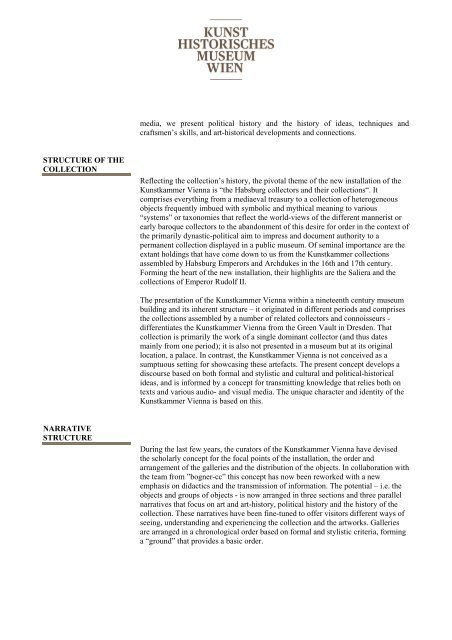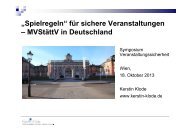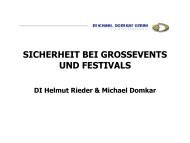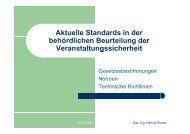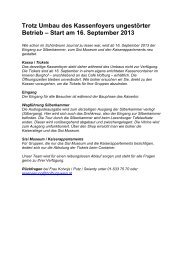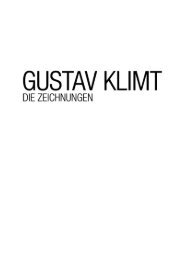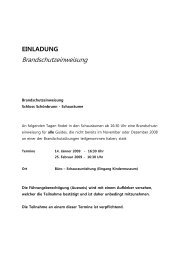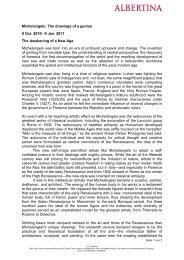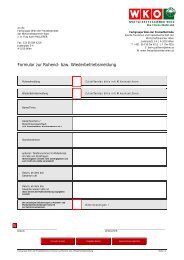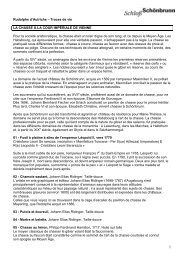kunstkammer vienna the cradle of the museum - Freizeitbetriebe ...
kunstkammer vienna the cradle of the museum - Freizeitbetriebe ...
kunstkammer vienna the cradle of the museum - Freizeitbetriebe ...
You also want an ePaper? Increase the reach of your titles
YUMPU automatically turns print PDFs into web optimized ePapers that Google loves.
STRUCTURE OF THE<br />
COLLECTION<br />
NARRATIVE<br />
STRUCTURE<br />
media, we present political history and <strong>the</strong> history <strong>of</strong> ideas, techniques and<br />
craftsmen’s skills, and art-historical developments and connections.<br />
Reflecting <strong>the</strong> collection’s history, <strong>the</strong> pivotal <strong>the</strong>me <strong>of</strong> <strong>the</strong> new installation <strong>of</strong> <strong>the</strong><br />
Kunstkammer Vienna is “<strong>the</strong> Habsburg collectors and <strong>the</strong>ir collections“. It<br />
comprises everything from a mediaeval treasury to a collection <strong>of</strong> heterogeneous<br />
objects frequently imbued with symbolic and mythical meaning to various<br />
“systems” or taxonomies that reflect <strong>the</strong> world-views <strong>of</strong> <strong>the</strong> different mannerist or<br />
early baroque collectors to <strong>the</strong> abandonment <strong>of</strong> this desire for order in <strong>the</strong> context <strong>of</strong><br />
<strong>the</strong> primarily dynastic-political aim to impress and document authority to a<br />
permanent collection displayed in a public <strong>museum</strong>. Of seminal importance are <strong>the</strong><br />
extant holdings that have come down to us from <strong>the</strong> Kunstkammer collections<br />
assembled by Habsburg Emperors and Archdukes in <strong>the</strong> 16th and 17th century.<br />
Forming <strong>the</strong> heart <strong>of</strong> <strong>the</strong> new installation, <strong>the</strong>ir highlights are <strong>the</strong> Saliera and <strong>the</strong><br />
collections <strong>of</strong> Emperor Rudolf II.<br />
The presentation <strong>of</strong> <strong>the</strong> Kunstkammer Vienna within a nineteenth century <strong>museum</strong><br />
building and its inherent structure – it originated in different periods and comprises<br />
<strong>the</strong> collections assembled by a number <strong>of</strong> related collectors and connoisseurs -<br />
differentiates <strong>the</strong> Kunstkammer Vienna from <strong>the</strong> Green Vault in Dresden. That<br />
collection is primarily <strong>the</strong> work <strong>of</strong> a single dominant collector (and thus dates<br />
mainly from one period); it is also not presented in a <strong>museum</strong> but at its original<br />
location, a palace. In contrast, <strong>the</strong> Kunstkammer Vienna is not conceived as a<br />
sumptuous setting for showcasing <strong>the</strong>se artefacts. The present concept develops a<br />
discourse based on both formal and stylistic and cultural and political-historical<br />
ideas, and is informed by a concept for transmitting knowledge that relies both on<br />
texts and various audio- and visual media. The unique character and identity <strong>of</strong> <strong>the</strong><br />
Kunstkammer Vienna is based on this.<br />
During <strong>the</strong> last few years, <strong>the</strong> curators <strong>of</strong> <strong>the</strong> Kunstkammer Vienna have devised<br />
<strong>the</strong> scholarly concept for <strong>the</strong> focal points <strong>of</strong> <strong>the</strong> installation, <strong>the</strong> order and<br />
arrangement <strong>of</strong> <strong>the</strong> galleries and <strong>the</strong> distribution <strong>of</strong> <strong>the</strong> objects. In collaboration with<br />
<strong>the</strong> team from ”bogner-cc” this concept has now been reworked with a new<br />
emphasis on didactics and <strong>the</strong> transmission <strong>of</strong> information. The potential – i.e. <strong>the</strong><br />
objects and groups <strong>of</strong> objects - is now arranged in three sections and three parallel<br />
narratives that focus on art and art-history, political history and <strong>the</strong> history <strong>of</strong> <strong>the</strong><br />
collection. These narratives have been fine-tuned to <strong>of</strong>fer visitors different ways <strong>of</strong><br />
seeing, understanding and experiencing <strong>the</strong> collection and <strong>the</strong> artworks. Galleries<br />
are arranged in a chronological order based on formal and stylistic criteria, forming<br />
a “ground” that provides a basic order.


